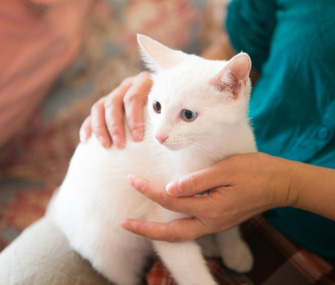Feline Fine: How to Read Your Cat’s Vital Signs
Published on January 02, 2014

Can you ever really say that a cat is normal? We all know that cats have their quirks, but when it comes to vital signs, there’s normal and there’s abnormal. Here’s what you should know about reading your cat’s lifelines.
Temperature
With their snazzy fur coats, cats don’t have much trouble keeping themselves warm. And thanks to their small body size and a few sweat glands, they are better than dogs at keeping themselves cool. Maybe that’s an artifact of their heritage as desert animals. Cats pant when they’re hot, but they also cool themselves by licking their fur and — sensibly— seeking out cool, dark places to rest when the temperature gets to be a bit much for them.
Nonetheless, it’s important not to let a cat get too hot, especially if you have a smush-faced breed such as a Persian. Never leave your cat in a car or other confined space on a hot day, not even in the shade with the windows cracked. Cats can and do suffer heatstroke, so take heed if your cat is breathing rapidly or noisily, drooling heavily and producing thick strings of saliva, and has a bright-red tongue and gums. If the cat’s temperature is more than 103 degrees Fahrenheit, get him to the veterinarian right away.
A cat’s body hums along at a temperature of 101.5 degrees Fahrenheit — a little higher than the normal human body temperature and about the same as dogs. A normal range is 100 to 102.5, so call your veterinarian if your cat’s temperature is higher or lower than that.
To take your cat’s temperature, lubricate a bulb or digital rectal thermometer with K-Y or petroleum jelly and gently insert it one to one and a half inches into the anal canal. Trust me, you’ll want an assistant to hold the cat firmly in a standing position during this process. Keep the thermometer in place for three minutes. Then remove it, wipe it down and read the temperature. After every use, clean the thermometer with alcohol. You can also take the easy route and purchase a thermometer that will read the temperature inside your cat’s ear.
Respiration
Cats at rest (their default state) normally take 20 to 30 breaths per minute. Breathing should be smooth, with exhales taking longer than inhales. To check your cat’s respiratory rate, count the number of times his chest rises and falls over a one-minute period.
Be concerned if your cat’s breathing is abnormal. That means it’s unusually slow, fast or noisy; has a high, harsh or whistling sound; or the cat is having difficulty breathing. And remember that a purr signals more than pleasure; it can also be a sign that a cat is in distress. Just because a cat is purring doesn’t mean he’s feeling good.
Heart Rate
An adult cat’s heart normally beats 140 to 220 times per minute with an average of 195 beats per minute. Newborn kittens have a heart rate of 220 to 260 beats per minute.
To check your cat’s pulse rate, put your hand on the inside of the rear leg at mid-thigh. You should feel the femoral artery pulsing near the surface. It’s easiest to find if your cat is standing or lying belly up. Count the number of beats you feel during a 15-second period and multiply by four to get the beats per minute.
Next time you’re at the clinic, ask your veterinarian to show you how to tell what’s normal in your cat. Knowing what to look for can save you some anxiety and get you to the vet on time when you do face an emergency.
The Importance of Cat Health Insurance
Your cat health insurance policy can help to offset unexpected treatment costs. These costs may include veterinary visits, prescription medications, or procedures such as imaging or surgery.
Find a personalized plan for your cat by using the insurance finder below:

